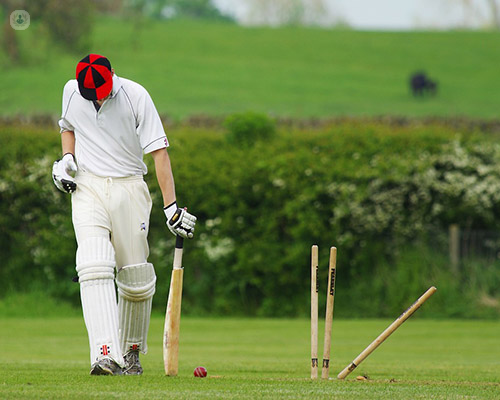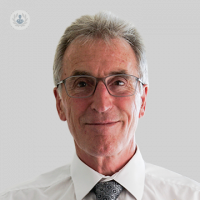Back pain and sports: improving your technique and getting the right treatment
Autore:Sports injuries are common, affecting many of those involved in athletics, team games, and many other sports, either in those who play professionally or as more of a hobby. Sports medicine is gaining strength as a specialty in the UK, with trained sports and exercise physicians working directly with players and athletes to promote physical fitness and prevent and treat sports-related injuries. Dr John Tanner, a leading musculoskeletal, sports and exercise physician, explains how back pain can occur in those who play sports, and what you can do to try reduce the risk of back problems developing.

What are the common causes of sports related back pain?
Most of the causes of back pain in those who play sports are the same as causes which affect the general population, but there are a few specific ones affecting the sporting population.
In general, the two biggest causes involve the facet joints, which are paired joints at the back of the spine which provide stability and control movement. They take and receive a lot of strain in extension and rotation, so they are prone to injury and pain.
The second equally common problem is a disc problem, as discs in the spine can prolapse or herniate and can pinch the nerve, leading to sciatica and pain down the leg.
The third is the sacroiliac joint, which joins the sacrum (a large triangular bone at the base of the spine) and the ilium bones of the pelvis. This joint has very strong powerful ligaments which can also be affected, and this pain can occur in almost any sport - particularly in runners, jumpers, and asymmetric sports like kayaking or canoeing.
The fourth, which is a very specific cause usually affecting very active junior or adolescent athletes, rugby players, or fast bowlers in cricket, is stress injury to a little bridge of bone between the joints. This can eventually wear through and cause a stress fracture, leading to more chronic problems.
The remainder of the more common problems in the sports person are muscle and ligament strains; which are ubiquitous but can become quite a nuisance.
What treatments are available for improving back pain?
Firstly, exercise is very important. There are some specific exercises and particular regimes which can be very helpful in recovery as therapy. There are also general kinds of exercise which look after the spinal column and the torso and help maintain stability in the long term. On top of this, general exercise will help promote weight loss and all-round fitness.
Secondly, very specific therapies which aim to mobilise and manipulate the joints can help in the more acute phases of back pain. These therapies are practised by physiotherapists, osteopaths and chiropractors particularly in the UK.
Thirdly, there are approaches which involve needling the muscles. These approaches can be called dry needling or acupuncture, which can help settle down muscle tension and relieve pain. A very important part of therapy is advising you, the patient, how to look after your back, which is all about posture. If we talk about posture abd back care in relation to the sports person, it may involve modifying the technique or the activity involved.
In the long-term, looking after your posture in everyday life is probably one of the most important things you can do to reduce back pain. In sports medicine and therapy, we teach what stems from the Alexander Method or Alexander Technique (a technique which promotes identifying harmful habits built up over time, and learning to move more freely). Then there are also more invasive treatments, and there are injections. We can use injections on the facet joints and the sacroiliac joint, and we can inject anti-inflammatory medicines and steroids around the disc and the nerve. There are also treatments which deal with more chronic pain arising from the facet joints, such as radiofrequency denervation. Surgery is also used as a treatment, but this is usually a last resort.
How can you prevent back pain caused by sports and exercise?
This is difficult to do. It has been shown, despite all efforts and studies, that teaching people how to use their back properly, and teaching correct lifting and handling, for example in industry doesn't seem to prevent the onset of first-time back pain. Since almost all of us, roughly 80% of the population, are at some time in our lives going to experience back pain, it is simply a part of everyday life and perhaps our upright activity. However, one thing we do know is that about 60% to 70% of disc problems which are related to disc degeneration are hereditary.
The other thing that is very important, of course, is taking care of your back. A lot of us do not really listen to our back or are aware of how we use our back until it actually starts hurting, which is often too late. It is very important to teach young people about correct posture and correct sitting, maintaining strength, mobility and fitness.
What advice would you give to young athletes to avoid stress and improve technique?
Make sure that you have good coaching and get advice from your trainer on your technique. One of the reasons that a stress injury in the bone occurs is based on the overload principle: either excess frequency, excessive intensity or a combination of both.
For example, if you are a 14-year-old fast-paced bowler, looking at your technique could help. If you have a front side-on action, a lot of twisting and extension and rotation in the spine is involved. This twisting and rotation movement is a higher risk factor for a particular bone stress injury called spondylolysis. It is not always easy to change technique but it can help reduce certain risks.
Furthermore, reducing frequency of repetitive actions, and coming off the pace a bit gives your back a chance to recover. Go down to the medium pace or, for example as a cricket player, try your hand at spin bowling if that's possible, so you are not putting such loads on your back. All of these small changes can make a difference. Perhaps most importantly, if you are a young person who is very actively engaged in sport, you need to listen to your back: don't ignore the symptoms.


